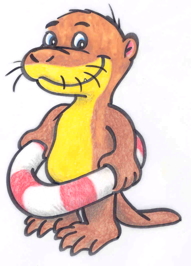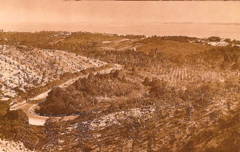Exploring Singapore’s biodiversity with the Raffles Museum Toddycats – reflections of a Canadian environmental biology exchange student at the National University of Singapore
By Nadine Galle, 9th May 2013.
“As a Canadian environmental biology exchange student at National University of Singapore, I was eager to get involved outside of my classes. I was looking for an outdoors environmental action group that would expose me to Singapore’s nature and the current issues it was facing.
Scrolling through NUS’ science associations and clubs, I stumbled upon the Toddycats, the vibrant volunteers of the Raffles Museum of Biodiversity Research (RMBR) at NUS.
The name – Toddycats – is a colloquialism for the common palm civet, Singapore’s last remaining wild carnivore species. It serves as a small reminder that Singapore is not just the concrete jungle that so many imagine it to be, but in fact, still boasts a wide range of rich biodiversity.
To join, I needed only a passion for nature and a desire to raise awareness for Singapore’s biodiversity, an easy requirement for me!
Toddycats coordinate a long-running programme, the International Coastal Clean-Up Singapore (ICCS), now in its 22nd year. I got my first exposure to the Toddycats by volunteering to help clean Tanah Merah beach where ICCS was organising a coastal cleanup for a local girls boarding school.
Fear of rain caused the group of over 100 girls to activate their plan B (promote good environmental habits at a park in the East Coast), so my two new Toddycat/ICCS friends – Gladys Chua and YiYong Yang – and myself made the most of it.
Welcoming and eager to share their knowledge, they gave me a crash course in Singapore’s marine biodiversity – something I hadn’t even covered in my classes at NUS!
I was hooked.
Hooked on the vast array of animal species. Hooked on the idea that so many species could exist in such metropolitan city. And hooked on learning more.
Gladys, Yi Yong, and I quickly made plans to visit Singapore’s Bukit Brown Cemetery, a notable heritage site and rich ecosystem which, like so many of Singapore’s historical and natural sites, faces the threat of destructive redevelopment.
My time with the Raffles Museum Toddycats came at a transitional time for them as they prepare to move their zoological collections and exhibitions, which are one of the largest collections of Southeast Asian biodiversity in the region.
The move, to a brand new and happily much larger location, will open as the Lee Kong Chian Natural History Museum, in late 2014 – a treat awaits university students and the public alike!

Assisting at the Raffles Museum Last Hurrah tour,
the first of the series led by Otterman aka N. Sivasothi
The present Raffles Museum’s Public Gallery closed on April 1st, 2013 so I was very fortunate to help usher some of the final tours through the museum – “the Last Hurrah” – as the Toddycats put it. The RMBR’s zoological collection dates back over a century and it was housed in the Faculty of Science museum since the late 1980s – so I am both lucky and grateful to have seen before it shifted.
Later in March, myself and more than 40 Toddycats cycled the 45 km “Otter Trail” which followed the northeastern coast of Singapore from Changi Village to Punggol. It proved to be much more than just a bike ride, filled with faunal action ranging from grey herons, hornbills, spotted wood owls, and even ten of the typically elusive smooth-coated otters.

At Sungei Tampines, a mangrove-lined stream along our Otter Cycling Trail
![41-Otter-Cycling-Trail-v2-24mar2013[kennethpinto]](https://i0.wp.com/farm8.staticflickr.com/7358/8719693530_22daeb0e82.jpg)
Watching the smooth-coated otter group at Lorong Halus Wetlands
The surprising richness of plant and animal life that has persisted here despite the detrimental impacts of urban development is truly astonishing.
Of course, nothing says wildlife perseverance like scuba diving across the bay from a Shell oil refinery plant. Through the Toddycats, I was able to meet the Hantu Bloggers, which raise awareness about Singapore’s small, yet biologically diverse reefs through the education of students and divers. I was yet again astounded by the amount of animal species that could thrive in such low-visibility (we were lucky to get 2 meters at best!) and murky waters of Pulau Hantu.
The Toddycats encouraged me to seek out the rest of Singapore’s nature. And throughout the rest of the semester I was able to hike through Bukit Timah, MacRitchie Reservioir, Southern Ridges, Kranji Countryside, Pulau Ubin, and Sungei Buloh Wetland Reserve. I had learned so much about Singapore’s wildlife with the Toddycats, I couldn’t help but share with whoever was willing to listen, and so my friends teasingly dubbed me the nature guide for all of our trips.
The Toddycats have taught me you must appreciate and understand your local environment before you can combat conserving biodiversity on a global scale. It has made me realize I am not as familiar with my local environment in Southwestern Ontario (Canada) as I should be.
My notion of a nature-less Singapore was shattered by the Toddycats, who revealed to me wildlife can thrive in the most unsuspecting of places. You really do not have to travel far to observe Singapore’s extraordinary biodiversity.
The Toddycats foster a celebration of their Singaporean natural heritage and cultural history. They form strong ties that bind people both within their group and between its various related organizations. But most significantly, they empower students and the public to be engaged in their local environment, something I have learned is the most important thing of all.
A very special thank you to Sivasothi, Airani, Gladys, YiYong, and Joelle for making my time so enriching and memorable. And to the rest of the Toddycats and all the lovely people at RMBR, ICCS, and Hantu Bloggers for sharing your knowledge and welcoming me with open arms!”
Photo albums
- Nadine Galle at Tanah Merah, 09 Mar 2013 – Flickr album
- Nadine Galle at Bukit Brown – Flickr album
- Otter Cycling Trail, 24 Mar 2013 – Flickr album 1 – Flickr album 2
- Raffles Museum Last Hurrah Tour, 18 Mar 2013 – Flickr album, Flickr Collection
Thanks Nadine, it was lovely hosting you; you were such a sweetheart. We wish you all the best for your future endeavours!
Raffles Museum Toddycats are just one of many environmental organizations active in conserving Singapore’s wilderness. Read about some of the others here.
And join all of us at the Festival of Biodiversity in July!





![18_ottertrail-24mar2013[ss]](https://i0.wp.com/farm9.staticflickr.com/8266/8623520047_431e745b64.jpg)











